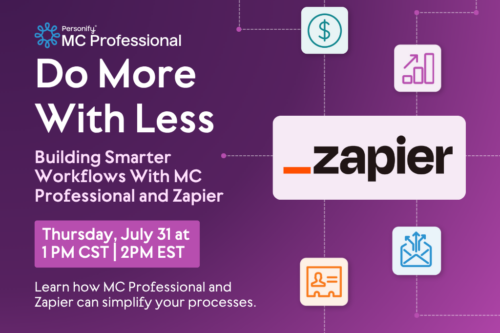In the digital era, associations and other organizations need to be able to move quickly and with agility. An executive committee can convene and act quickly and decisively when it counts. These committees are becoming more and more common in for-profit companies, nonprofit organizations, and member associations. They’ve become common in larger nonprofits, with executive committees present at 76% of nonprofit organizations. But, what is this committee and what do they do? We’ll explore the purpose and the value they can bring.
What is an Executive Committee? (Overview, Roles, and Responsibilities)
Executive committees, which are also known as standing committees, are governing bodies that work closely with others in leadership roles in an organization to handle both daily operations and urgent matters. Often, the committee will include the chair or vice president, vice president, treasury, secretary, and the leaders of any other standing committees. They’re a group large enough to have a wealth of institutional knowledge, involved enough in the day to day to give good counsel, and present enough that they can work quickly when events require it.
Executive Committee vs. Board of Directors
The composition and name can make this sound a lot like the board of directors. But, the executive committee has distinct roles and duties that are different from the board’s. In many ways, the executive committee exists to help ensure the board’s vision is enacted daily through the association’s activities.
The board of directors looks at long-term strategy and governance. The executive committee’s job involves advising CEO and other leaders and taking actions to put the board of directors’ wishes into effect. The committee will meet monthly or more often, as needed, while the board has regularly scheduled meetings.
An executive board is appointed from within and includes top executives from the organization. Their power is limited and subject to board approval. Often, they will handle issues rapidly that the board can’t respond to as expeditiously.
The board of directors, by contrast, is made up of elected members and has the ultimate authority in the direction of the organization. Often, people outside the day-to-day workings of the organization serve on its board. This allows them to have the neutrality necessary to make decisions without bias.
The two groups work in tandem to ensure the association is heading in a direction that serves its members and its community well. Having this layer between the board and individuals means having smoother operation and more strategic and directed actions and decision-making.
Executive Committee Roles & Responsibilities
The specific tasks and decisions the executive committee is responsible for lie somewhere between those of the CEO and other leadership level professionals and those of the board. Executive committee roles and responsibilities will vary with the priorities of each specific company or association. Each will have different ways of operating that are customized to a specific organization’s needs. These are some of the duties that are most common.
The committee’s powers and roles have certain limits. For instance, they aren’t in a position to overrule decisions made by the full board of directors. Rather, their role is to finesse day to day operations to be sure the organization proceeds in a way that is in line with the values and strategies of the association as a whole. By acting as a layer between a board of directors and an individual CEO, they can help ensure the association’s goals are always at the forefront.
1. Providing Organizational Direction and Acting on Behalf of the Board
The board of directors have a holistic view of the association, providing general guidance and steering. The CEO is on-hand to deal with a wide range of daily issues.
The executive committee is in the middle, handling some time-sensitive decisions and determining which items require the attention of the full board of directors. By working in this way, they can provide a wider, more nuanced viewpoint than you’d get having decisions made by a single executive officer or the board itself.
They also help execute the strategies that the board has decided on. This is accomplished both through advising the CEO and by helping to manage daily operations.
2. Providing Organizational Oversight
How are the people at the C-level doing? Is the association serving its members well? Organizations hire executives to achieve specific company goals and perform day to day duties. The executive committee has the insight to examine how the C-level employees are performing and whether adjustments need to be made.
The executive committee also has a valuable role in monitoring and compliance. They can keep an eye on daily operations to be sure that actions are in line with both company policies and applicable regulations.
3. Managing High-Level Workplace Issues of a Serious Nature
One of the purposes of an executive committee is having a body that can make the best decisions possible to counter any potential damage.
When serious issues arise, there may not be time to have the whole board of directors convene and make a plan. The executive committee is made up of people appointed from within the company. They have insights into the workings of the business and the experience to handle serious issues quickly and carefully.
4. Making Decisions in an Emergency
Major decisions in a company are typically made only after a great deal of research and discussion. But, that isn’t always possible. Natural disasters, public relations issues, sudden losses of key executives and other circumstances can mean decisions need to be made quickly. The executive committee can react quickly to take care of urgent issues. Any decisions they make can be evaluated later on by the full board. Over time, this group will help develop even more nuanced answers to common issues, allowing your organization to operate more smoothly.
5. Offering training and professional development opportunities for executives.
No one is born knowing how to lead an organization. When you get the full executive committee in a room, you’ll have decades of operational knowledge at your disposal. The committee can offer both formal training programs and individual mentorship to up-and-coming executives to help them become more effective, more experienced leaders.
Who Should Be On the Executive Committee
The executive committee should include high level executives, along with the leaders of other standing committees in the company or leaders of temporary task groups. This can include the company’s chair or president, vice chair, secretary, treasurer, and others.
Don’t overlook past executives. Their experience can bring expertise and insights that broaden the committee’s viewpoints. The number of members and their specific roles inside the organization will vary depending on the talent there is to pull from and the specific needs of the company.
Appointing an Executive Committee
The board of directors will appoint the members of the executive committee. Typically, a company’s bylaws will spell out exactly who will serve on an executive committee. Most have between three and seven members. Research indicates that a seven-member committee is just the right size for optimal decision-making. Every committee member over that lowers efficiency by about 10%.
Meetings of the Executive Committee
The executive committee typically meets more often than the board of directors. Meetings may be held once a month, quarterly, or whenever they are needed. The frequency can be changed depending on the company’s needs. During some periods, there will be no need to meet more than every few months. During turbulent times, it may be necessary to meet more often to make decisions and implement them.
Communication and Board Development
The executive committee can communicate the needs of the company to the board of directors. For instance, one of the board’s duties can be setting agenda items for the next meeting of the board of directors.
When Should a Board Establish an Executive Committee?
An executive committee becomes an asset when an organization starts getting large and complex. The executive committee can streamline decision-making. This allows the association to respond with agility when surprises and opportunities come up.
Do you often find you aren’t sure how to handle situations in a way that is consistent with the association’s goals or the wishes of the board of directors? Are there situations that don’t seem to fit neatly within your prescribed rules? Do issues tend to come up between scheduled board meetings? The flexibility and agility an executive committee add could be just what your association needs to break out of uncertainty and get back to serving your members.
Final Thoughts
When an organization hits a certain size and complexity, its decision-making needs become more complex, as well. An executive committee can play a large role in assuring that the daily operation of an organization is in line with the values and goals of the association as a whole. By pulling together your best talent and giving them the power to make the decisions needed, you can ensure your association thrives and serves its members and community well.
















